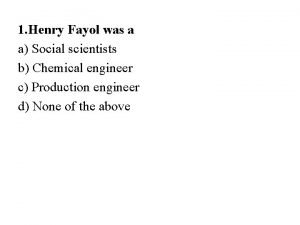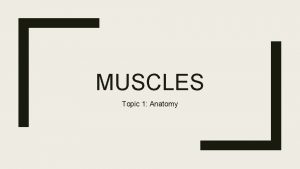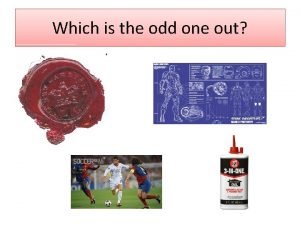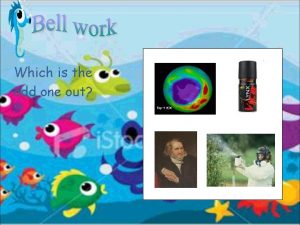Starter odd one out Which is the odd






















- Slides: 22

Starter: odd one out Which is the odd one out and why? Think carefully about the definition of each key word. It is vitally important in the exam that you do not mix these terms up!!!! Cure Vaccination Immunisation A disease that has been caught can be successfully healed. A way of preventing a disease being caught by issuing an injection of weaker germs gain immunity (through producing antibodies)

L 20: 20 th Century Medicine: Developments in the fight against disease: The magic bullet • Be able to define the difference between prevention and cure. • Be able to describe how many individuals built upon each others work to develop the first ‘magic bullet’ cures. • Understand the factors involved in the development of magic bullets to cure disease • Understand the significance of the development of magic bullets in finding cures for diseases.

Task 2: Revision – Dingbats Use the picture clues to recall who did what! y r eo Th A

Task 3: The move towards CURING disease: Slavarsan 606: The magic bullet. You are going to be read a story about 5 different men. Each man helped to build understanding about how to treat the cause of a disease. Ultimately, the diagram ends with the man who was successfully able to CURE disease with a type of DRUG dubbed ‘the magic bullet’ • Read page 154 and 155 in your text book. • Make Cornell notes on what you read. • Use the card sort labels to complete the diagram. But there were many steps before DOMAGK could develop this CURE. He relied upon the work of the men before him.

Individual 1: Koch • Koch developed Pasteur’s work on the Germ Theory – this was an important breakthrough in understanding how disease is spread. • Koch identified the different bacteria that cause disease through close study. • Koch discovered that he could stain certain bacteria – this helped him to see them better underneath the microscope.

Individual 2: Behring • Behring developed Koch’s ideas further. He successfully identified which anti-toxins (anti bodies) were created by the body to fight the microbe causing diphtheria. • Koch’s techniques in staining microbes so that they could easily be studied helped. • By injecting the anti-toxins into the body of someone with Diphtheria Behring was able to cure the disease – the anti-toxins only targeted the microbes causing the disease. • He was later able to use this idea to create a vaccine to prevent diphtheria altogether.

Individual 3: Ehrlich • Ehrlich was part of Koch’s research team. He wanted to build upon the work of Behring. • Ehrlich knew that certain dyes stained certain microbes (Koch’s work) and that anti toxins only attacked the disease microbes (Behring’s work). • Ehrlich was fascinated by the way the body created anti-bodies that killed bacteria but did not harm anything else. Ehrlich thought that these anti toxins were like ‘magic bullets’; He thought a chemical could be found which would work like an anti toxin produced by the body. • He spend hours staining bacteria and watching the effects of the dye. He was looking for a ‘magic bullet’ to treat Syphilis. Despite years of work he had little success. Luckily his research was government funded. • He started to use chemical compounds to kill the bacteria. They tried over 605 variations.

Individual 4: Hata • 1909 – Dr Sahachiro Hata joined Ehrlich’s research team. • When reviewing Ehrlich’s experiments to find the ‘magic bullet’ for Syphilis he discovered a mistake. The 606 th experiment findings had been dismissed – but they had been effective. Hata proved that 606 killed the Syphilis bacteria. • The first magic bullet to cure syphilis was called Slavarsan 606. The only problem was it didn’t just kill the bacteria. . it killed the patient too! • BUT the use of chemical drugs instead of plants/herbs to target and cure illness was an important breakthrough.

Individual 5: Domagk • Cuts and scratches could lead to blood poisoning through becoming infected so this was an important discovery. • Domagk discovered that a particular red dye, called Prontosil, was effective against blood poisoning. • He tested Prontosil on mice – it had good results – killing the bacteria causing blood poisoning. • Domagk tested Prontosil on his own daughter when she developed blood poisoning from the prick of an infected needle – he saved her life. • The development of ELECTRON MICROSCOPES in 1931 allowed him to identify the active CHEMICAL COMPOUND in Prontosil - which was SULPHONOMIDE. • Over the next few years drug companies rushed to discover cures based on sulphonomides – the pharmaceutical industry boomed - this led to cures for scarlet fever, meningitis and pneumonia. This led to a huge improvement in health.

The Answers:

Robert Koch Positives: Negatives: Emil Von Behring Paul Ehrlich Dr Sacachiro Hata Gerhard Domagk

Plenary: Analysing strengths & Weaknesses of the magic bullet development Consider each of the factors on page 2 of the Activ. Inspire flipchart Which positives and negatives refer to which person? Complete your table.

Plenary: Role play consolidation

Resources below

DOMAGK HATA EHRLICH BEHRING KOCH 1880 s 1890 s 1905 1909 1932

Robert Koch Positives: Negatives: Emil Von Behring Paul Ehrlich Dr Sacachiro Hata Gerhard Domagk

Individual 1: Koch • Koch developed Pasteur’s work on the Germ Theory – this was an important breakthrough in understanding how disease is spread. • Koch identified the different bacteria that cause disease through close study. • Koch discovered that he could stain certain bacteria – this helped him to see them better underneath the microscope.

Individual 2: Behring • Behring developed Koch’s ideas further. He successfully identified which anti-toxins (anti bodies) were created by the body to fight the microbe causing diphtheria. • Koch’s techniques in staining microbes so that they could easily be studied helped. • By injecting the anti-toxins into the body of someone with Diphtheria Behring was able to cure the disease – the anti-toxins only targeted the microbes causing the disease. • He was later able to use this idea to create a vaccine to prevent diphtheria altogether.

Individual 3: Ehrlich • Ehrlich was part of Koch’s research team. He wanted to build upon the work of Behring. • Ehrlich knew that certain dyes stained certain microbes (Koch’s work) and that anti toxins only attacked the disease microbes (Behring’s work). • Ehrlich was fascinated by the way the body created anti-bodies that killed bacteria but did not harm anything else. Ehrlich thought that these anti toxins were like ‘magic bullets’; He thought a chemical could be found which would work like an anti toxin produced by the body. • He spend hours staining bacteria and watching the effects of the dye. He was looking for a ‘magic bullet’ to treat Syphilis. Despite years of work he had little success. Luckily his research was government funded. • He started to use chemical compounds to kill the bacteria. They tried over 605 variations.

Individual 4: Hata • 1909 – Dr Sahachiro Hata joined Ehrlich’s research team. • When reviewing Ehrlich’s experiments to find the ‘magic bullet’ for Syphilis he discovered a mistake. The 606 th experiment findings had been dismissed – but they had been effective. Hata proved that 606 killed the Syphilis bacteria. • The first magic bullet to cure syphilis was called Slavarsan 606. The only problem was it didn’t just kill the bacteria. . it killed the patient too! • BUT the use of chemical drugs instead of plants/herbs to target and cure illness was an important breakthrough.

Individual 5: Domagk • Cuts and scratches could lead to blood poisoning through becoming effective so this was an important discovery. • Domagk discovered that a particular red dye, called Prontosil, was effective against blood poisoning. • He tested Prontosil on mice – it had good results – killing the bacteria causing blood poisoning. • Domagk tested Prontosil on his own daughter when she developed blood poisoning from the prick of an infected needle – he saved her life. • The development of ELECTRON MICROSCOPES in 1931 allowed him to identify the active CHEMICAL COMPOUND in Prontosil - which was SULPHONOMIDE. • Over the next few years drug companies rushed to discover cures based on sulphonomides – the pharmaceutical industry boomed - this led to cures for scarlet fever, meningitis and pneumonia. This led to a huge improvement in health.

Task 1: Why did life expectancy increase in the 20 th Century? • Pie charts import image.
 Henri fayol parents
Henri fayol parents Which is correct
Which is correct Chip chick shot odd one
Chip chick shot odd one Odd one out
Odd one out What figurative language is you're my kryptonite
What figurative language is you're my kryptonite Plot setting stage language odd one out
Plot setting stage language odd one out Equivalent fractions odd one out
Equivalent fractions odd one out Pick the odd one out
Pick the odd one out Odd one out
Odd one out Odd one out
Odd one out Stepsort
Stepsort Find the odd one out brother sister mother grandson
Find the odd one out brother sister mother grandson Odd one out
Odd one out Odd one out
Odd one out Dessin fractions
Dessin fractions Even degree polynomial function
Even degree polynomial function Defination of odd numbers
Defination of odd numbers Structure of skeletal muscle
Structure of skeletal muscle Find 2 odd miis out
Find 2 odd miis out Stick coded as rshbj
Stick coded as rshbj Odd man out trivial unimportant important insignificant
Odd man out trivial unimportant important insignificant Odd phonetic transcription
Odd phonetic transcription One god one empire one religion
One god one empire one religion








































